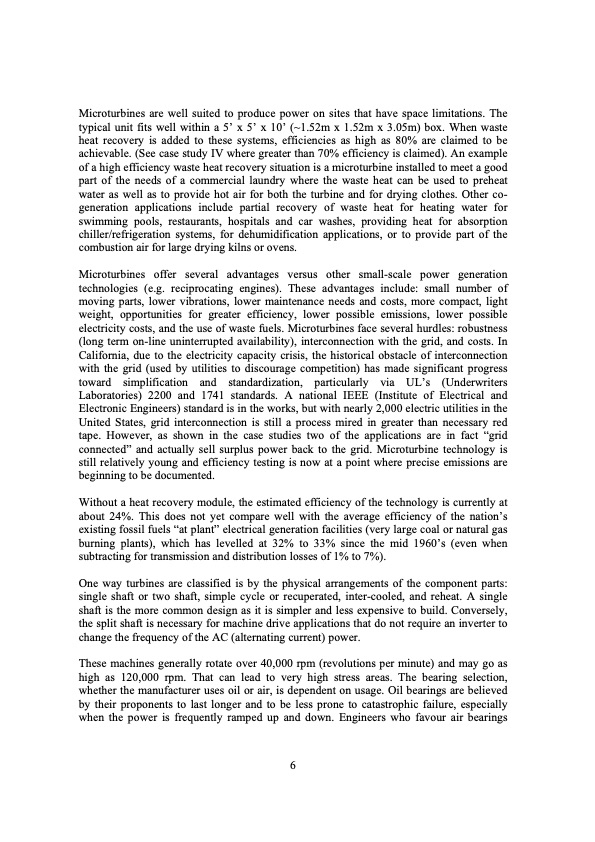
PDF Publication Title:
Text from PDF Page: 009
Microturbines are well suited to produce power on sites that have space limitations. The typical unit fits well within a 5’ x 5’ x 10’ (~1.52m x 1.52m x 3.05m) box. When waste heat recovery is added to these systems, efficiencies as high as 80% are claimed to be achievable. (See case study IV where greater than 70% efficiency is claimed). An example of a high efficiency waste heat recovery situation is a microturbine installed to meet a good part of the needs of a commercial laundry where the waste heat can be used to preheat water as well as to provide hot air for both the turbine and for drying clothes. Other co- generation applications include partial recovery of waste heat for heating water for swimming pools, restaurants, hospitals and car washes, providing heat for absorption chiller/refrigeration systems, for dehumidification applications, or to provide part of the combustion air for large drying kilns or ovens. Microturbines offer several advantages versus other small-scale power generation technologies (e.g. reciprocating engines). These advantages include: small number of moving parts, lower vibrations, lower maintenance needs and costs, more compact, light weight, opportunities for greater efficiency, lower possible emissions, lower possible electricity costs, and the use of waste fuels. Microturbines face several hurdles: robustness (long term on-line uninterrupted availability), interconnection with the grid, and costs. In California, due to the electricity capacity crisis, the historical obstacle of interconnection with the grid (used by utilities to discourage competition) has made significant progress toward simplification and standardization, particularly via UL’s (Underwriters Laboratories) 2200 and 1741 standards. A national IEEE (Institute of Electrical and Electronic Engineers) standard is in the works, but with nearly 2,000 electric utilities in the United States, grid interconnection is still a process mired in greater than necessary red tape. However, as shown in the case studies two of the applications are in fact “grid connected” and actually sell surplus power back to the grid. Microturbine technology is still relatively young and efficiency testing is now at a point where precise emissions are beginning to be documented. Without a heat recovery module, the estimated efficiency of the technology is currently at about 24%. This does not yet compare well with the average efficiency of the nation’s existing fossil fuels “at plant” electrical generation facilities (very large coal or natural gas burning plants), which has levelled at 32% to 33% since the mid 1960’s (even when subtracting for transmission and distribution losses of 1% to 7%). One way turbines are classified is by the physical arrangements of the component parts: single shaft or two shaft, simple cycle or recuperated, inter-cooled, and reheat. A single shaft is the more common design as it is simpler and less expensive to build. Conversely, the split shaft is necessary for machine drive applications that do not require an inverter to change the frequency of the AC (alternating current) power. These machines generally rotate over 40,000 rpm (revolutions per minute) and may go as high as 120,000 rpm. That can lead to very high stress areas. The bearing selection, whether the manufacturer uses oil or air, is dependent on usage. Oil bearings are believed by their proponents to last longer and to be less prone to catastrophic failure, especially when the power is frequently ramped up and down. Engineers who favour air bearings 6PDF Image | Glotec Global Technology Network LP Gas Use in Microturbine Applications

PDF Search Title:
Glotec Global Technology Network LP Gas Use in Microturbine ApplicationsOriginal File Name Searched:
lp-gas-use-in-microturbine-applications-2002.pdfDIY PDF Search: Google It | Yahoo | Bing
Capstone Turbine and Microturbine: Capstone microturbines used and new surplus for sale listing More Info
Consulting and Strategy Services: Need help with Capstone Turbine, sizing systems, applications, or renewable energy strategy, we are here to assist More Info
Container Lumber Dry Kiln: Since 1991 developing and innovating dry kilns using standard shipping containers More Info
Supercritical CO2 Lumber Dry Kiln: Compact fast drying in 3 days or less for small amounts of wood and lumber drying More Info
BitCoin Mining: Bitcoin Mining and Cryptocurrency... More Info
Publications: Capstone Turbine publications for microturbine and distributed energy More Info
FileMaker Software for Renewable Energy Developing database software for the renewable energy industry More Info
CO2 Gas to Liquids On-Demand Production Cart Developing a supercritical CO2 to alcohol on-demand production system (via Nafion reverse fuel cell) More Info
Stranded Gas for low cost power Bitcoin Mining Using stranded gas for generators may provide breakthrough low power costs for cryptocurrency miners. More Info
| CONTACT TEL: 608-238-6001 Email: greg@globalmicroturbine.com | RSS | AMP |